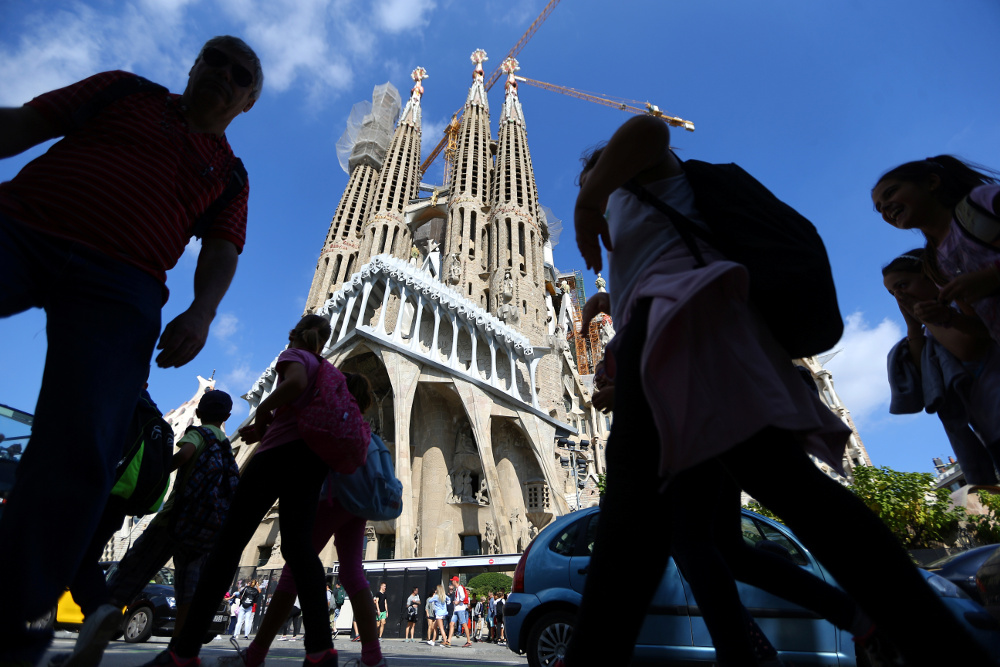
People walk near the Sagrada Familia basilica in Barcelona, Spain, Oct. 11. (CNS/Reuters/Ivan Alvarado)
When the government of Luxembourg abolished religious teaching in state schools in September, the move was deplored by the Grand Duchy's Catholic archdiocese.
Catholics traditionally make up two-thirds of Luxembourg's 530,000 inhabitants, and their archbishop, Jean-Claude Hollerich, consented in 2015 to plans by the center-left government of Xavier Bettel, Europe's only openly gay prime minister, for full church-state separation to be phased in over two decades.
But scrapping religious classes hadn't been agreed.
"This country possesses a long, well-functioning tradition in this field," explained Patric De Rond, the church's head of religious teaching. "An additional burden will now fall on parents who can no longer count on school help, and everything will have to be done by parishes."
What made the task more daunting, De Rond told Vatican Radio, was the church's recent reorganization, which had reduced Luxembourg's existing 274 Catholic parishes to just 33. How could such a small pastoral network possibly meet the challenge?
In reality, such problems have been facing the church all over Europe, as its local leaders seek to adapt structurally and pastorally to falling numbers and dwindling participation. Elsewhere too, clustering and merging parishes have offered a potential solution; and while they have been tackled differently across the continent, those behind the changes are determined to see them in a positive light.
"We have to discern what Christ wants from us now, not just continue what we've done in the past — and provided we find the right answers, we should be optimistic," Michael Prüller, spokesman for Austria's large Vienna Archdiocese, told NCR. "While there'll always be sorrows and discomforts when old patterns are left behind, everyone realizes you can't just hide your head in the sand."
Under a major reorganization, unveiled in 2012, the Vienna Archdiocese's 660 parishes are being merged into 150 larger entities, each served by three to five priests. Austria's smaller Feldkirch Diocese is conducting a parallel reform, cutting down to just nine urban parishes, with 36 "parochial associations." Other dioceses have followed suit, each in their own way, with at least one bishop, Alois Schwarz of Graz, rejecting "large-scale pastoral areas" and opting to retain smaller parishes.
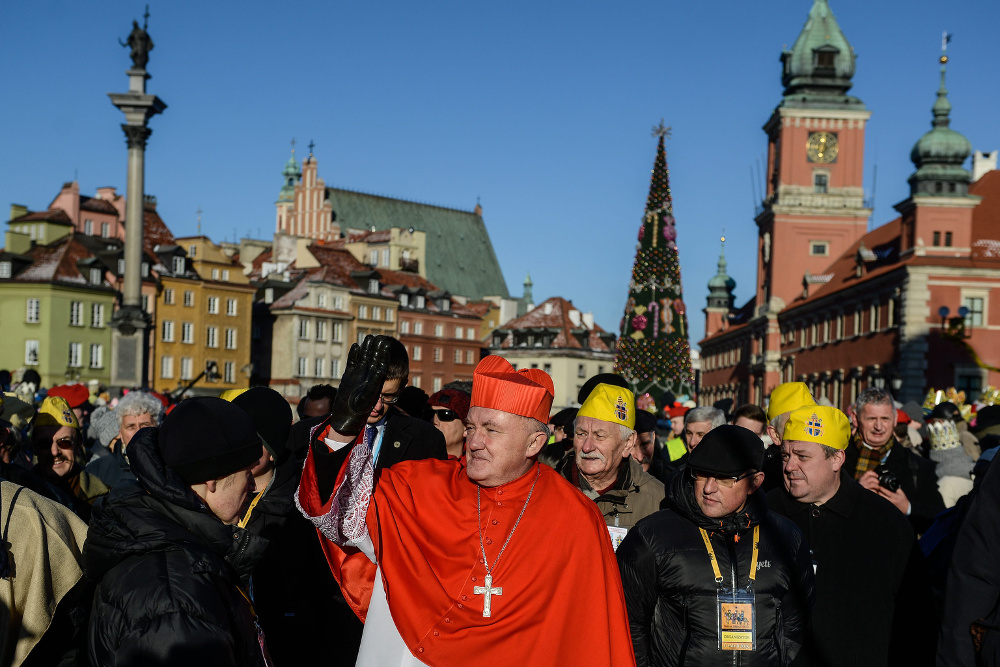
Cardinal Kazimierz Nycz of Warsaw, Poland, waves during the Three Kings parade in celebration of the feast of the Epiphany in Warsaw, Poland, Jan. 6, 2015. (CNS/EPA/Jakub Kaminski)
All over Europe
Meanwhile, similar reorganizations have been underway around Europe, where a huge drop in church membership and participation since the 1960s has accelerated over the past decade, despite determined church efforts to reach out with new forms of evangelization.
In traditionally Catholic Italy, up to 40 percent of Catholic parishes are now run by foreign-born clergy, while in Spain, where Catholics traditionally make up four-fifths of the population of 40 million, only one in five Catholics now attends Mass, according to recent data, and many of the country's 68 dioceses report no seminary admissions.
In 2013, after repeated clashes with the previous Socialist government over secular education, same-sex marriage and relaxed divorce and abortion laws, Spain's bishops' conference urged Catholics to "join forces, share experiences and people, and prioritize spending resources."
In neighboring France, where fewer than 1 in 10 Catholics now attends Sunday Mass, priestly vocations have also fallen, leaving many of the country's 36,000 parishes without resident pastors and fueling fears that one-fifth of its 15,000 historic churches could face closure.
In Ireland similarly, regular Mass attendance among Catholics has plummeted, and seven out of eight Catholic seminaries have closed, leaving just 19 ordinands to begin training this September.
Even in Poland, church leaders have warned they may soon have to withdraw priests from working abroad and begin merging some of the country's 11,000 parishes, as admissions to Poland's 84 diocesan and religious order seminaries decline, accompanied by a sharp fall in recruitment to Poland's 104 female orders and congregations. In June, Cardinal Kazimierz Nycz of Warsaw confirmed plans to recruit and incardinate visiting clergy from India, Vietnam and the Philippines.
Advertisement
In Britain, reorganizations are underway, with the Archdiocese of Birmingham now running a special "Future Planning" section on its website.
It's a "sign of the times" to have priests working together across neighboring parishes, Birmingham Archbishop Bernard Longley explained in a recent message, and to have laity helping with administrative tasks so clergy can "focus on their primary roles of sacramental ministry, catechesis, prayer and pastoral care."
Margaret Doherty, communications director for the Bishops' Conference of England and Wales, says newly emerging forms of Catholic life are designed to ensure "people are looked after and lay Catholics play an active role." But each diocese will have its own needs, clergy profile and mission aims, so the reforms can't be coordinated centrally or nudged in particular directions with models or best practices.
"There've been consultations, so people at all levels can be notified and involved, and taken along with the process," Doherty explained to NCR. "While change is always difficult, and sometimes traumatic, it's usually a positive thing. I haven't heard of any theological treatises against these reforms, and I'm sure we can be optimistic."
Although the idea of "Christian Europe" is still vigorously defended in many quarters, most experts now concur that traditional church methods and structures are having to change. The idyllic picture of a church and priest in every village now firmly belongs to history.
This is evident in Germany, where Catholics still make up 30 percent of the population of 82.6 million. The German church is comparatively rich, thanks to its membership tax system, which was introduced in the 19th century to compensate for state seizures of ecclesiastical property and earns the church around 5 billion euros (US $6 billion) yearly.
But Catholics have been stopping payments and leaving the church at the rate of some 150,000 annually, while Mass attendance among those still registered has halved in the last three decades. This has required some rethinking.
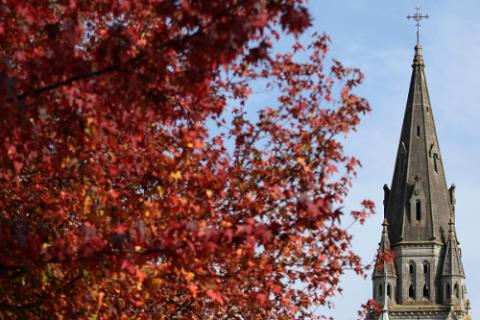
Leaves frame the steeple of a church Oct. 17 as autumn weather arrives in Orvault, France. (CNS/Reuters/Stephane Mahe)
In its annual report this October, Germany's largest diocese numerically, Cologne, which has 2 million members, posted revenues of 917 million euros (US $1.085 billion), 4 percent up from the previous year. Most came from the church tax and was used for salaries, building maintenance and handouts to parishes, which are now grouped into 180 "pastoral care areas."
When it comes to restructuring, Cologne's archbishop, Cardinal Rainer Maria Woelki, is something of a veteran. In 2012, when head of Germany's Berlin Archdiocese, he announced another major shake-up, involving the merger of 105 local parishes into 35 "pastoral spaces" and the pooling of resources in youth work, charitable activity and other fields.
"The charisma of priests and pastors will be better oriented than before," Woelki explained in a pastoral letter, "so everyone can use their special gifts in sacramental ministry, catechesis and pastoral work, and church life can be networked through small spiritual cells living by the Gospel."
The need for change was obvious.
After Germany's 1989-90 reunification, the Berlin Archdiocese had run up debts of $140 million; and by 2009, it had sold unused churches and laid off 40 percent of its clergy, administrators and staffers.
Even now, the archdiocese is forecast to lose a further third of its membership by 2030, while Catholic schools, nurseries, hospitals and elderly homes are reorganized to reflect a "diaspora experience." But the 35 pastoral spaces are now up and running under its new archbishop, Heiner Koch, reassigned from Dresden in 2015.
While a parish requires a priest "as its proper pastor" under the church's Code of Canon Law, a community can be run by laity.
Stefan Foerner, the archdiocese spokesman, is cautious when it comes to a greater role for laity in ministering or celebrating Mass. But lay Catholics are now "decisively involved" at all levels of church life, he says, and seen as "sharing in the universal priesthood."
"The era of a popular folk church is over — we've had to reshape our structures and find new ways of working with each other," Foerner told NCR. "We've called this process, 'Where faith gains space,' and the central concern has been to provide spiritual self-assurance in a rapidly changing environment. The church must remain committed to Christ's mission, and translate this into a language for new circumstances."
No reorganization blueprint
Similar reforms have been underway in Germany's Hamburg Archdiocese, which, like Berlin's, is centered on a large metropolitan area, as well as in local dioceses such as Trier, where Bishop Stefan Ackermann announced plans after a 2016 diocesan synod to reduce his parishes from 900 to 60.
Designated laypeople will have the right to conduct funerals and "proclaim and preach in different worship forms," Ackermann explained, while the "traditional image" of clergy would give way to a greater emphasis on teamwork.
"There'll continue to be a priest who takes overall responsibility, but tasks and duties will also be distributed by the team — so there'll be less emphasis on the clergy's leadership, and more on its priestly and pastoral functions," the bishop told Germany's Catholic news agency, KNA. "The church shouldn't be designed as a self-serving association. Faithful believers in the communities can serve local Catholic needs if, alongside regular celebrations of the Eucharist, new forms of worship are developed."
There may be no reorganization blueprint. But people like Ackermann will certainly have checked out reforms being implemented elsewhere, and may well have drawn practical lessons from what's now underway in nearby Austria.
When he unveiled the Vienna Archdiocese's reorganization back in 2012, Cardinal Christoph Schönborn admitted it would mean "saying goodbye to much that's dear to us," but was adamant the changes would allow more time for evangelization by reducing bureaucracy and helping pool resources.
"This is about a new cooperation between priests and laity from their common Christian vocation," the cardinal told a press conference at the time. "We have to free ourselves of the traditional image that the church is present only where there's a priest, and stress the common priesthood of all baptized."
Although the reforms were supported by several Austrian newspapers, including the mass-circulation Die Presse daily, they faced tough opposition within the church. Austria's dissenting Priests' Initiative, which has demanded women clergy and Communion for divorced and remarried people, pledged to resist it, while the 13,000-member "Laien Initiative," or Lay Initiative association, dismissed it as "an evasive maneuver" to "maintain the power of clergy."
But Michael Prüller, the archdiocese spokesman, says opposition has now largely dissipated. Since the changes began, 30 parishes have been merged into larger "pastoral areas," each grouping several communities run by lay volunteers authorized to conduct Services of the Word.
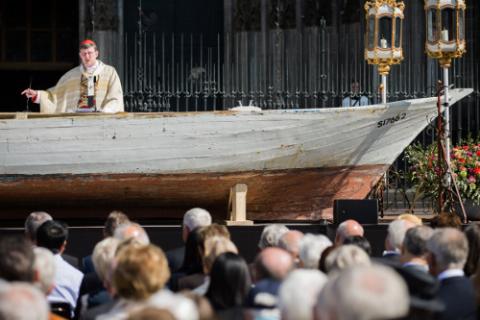
German Cardinal Rainer Maria Woelki celebrates a Corpus Christi Mass on a refugee boat serving as an altar in front of the cathedral in Cologne in May 2016. (CNS/EPA/Rolf Vennenbernd)
The emphasis, Prüller insists, has been on reinvigorating missionary impulses, and after lengthy consultations, most lay Catholics have come around to the idea. So, according to a late 2016 survey, have most local priests, who've been reassured the new larger entities will leave them freer for pastoral work without "losing the nearness of people to their church."
"We've let parishes decide for themselves here and drawn up the changes with them in line with how they see their pastoral and missionary priorities," Prüller told NCR. "We've also done it all at our own pace and in our own way, without looking for models elsewhere. If there's been any 'master-plan,' it's been only the plan we've acquired from our Master."
Prüller thinks the pattern of larger pastoral areas comprising smaller communities, with "development regions" earmarked for special missionary efforts, has been the right way to go.
While a parish requires a priest "as its proper pastor" under the church's Code of Canon Law, with articles 515-552 setting out clear rules, a community can be run by laity. Provided the rules and procedures are followed, particularly when it comes to notifying clergy, local dioceses can count on a free hand without interference from the Vatican.
"People are talking more and more now about how the church can reorganize to fulfill its pastoral plans and mission tasks more effectively — I think this is something the reorganization has achieved," Prüller said. "As pastoral teams become established, the idea of a 'lone ranger' priest running everything in his local domain looks set to become a thing of the past. After all, Jesus sent his followers into the world in pairs and groups, not as individuals."
It remains to be seen whether other dioceses will follow Vienna's example.
Polish, Orthodox growth trends
Some have handed underused churches to incoming Catholic migrant communities, notably to Poles, who've become the largest minority in Ireland since their country joined the European Union in 2004, and are now a substantial presence throughout Europe.
Perhaps fearing the effects of integration, the Polish church has sent its own clergy to countries such as Britain, where a London-based Polish mission with over 100 priests run 86 separate parishes and celebrates Polish-language Masses at around 200 locations.
This has provoked disputes.
At Essen in Germany, where the diocese has sold off around 100 churches, trouble erupted this summer when the city's 75,000 Poles were told the church they'd been allowed to use, St. Clement's, was also earmarked for sale.
Meanwhile, some dioceses have also loaned or given unused places of worship to Orthodox churches, which have also expanded rapidly in Western Europe with post-communist immigration. Russia's Orthodox Church alone has set up over 400 parishes in 52 countries since the Soviet Union collapsed in 1991 and plans to build its own cathedrals and basilicas in cities ranging from Madrid in Spain to Nicosia in Cyprus. In Paris, a massive new Russian Orthodox cathedral and culture center were dedicated on the Quai Branly in October 2016, after the church's Western Korsun Diocese outbid Saudi mosque builders for the site.
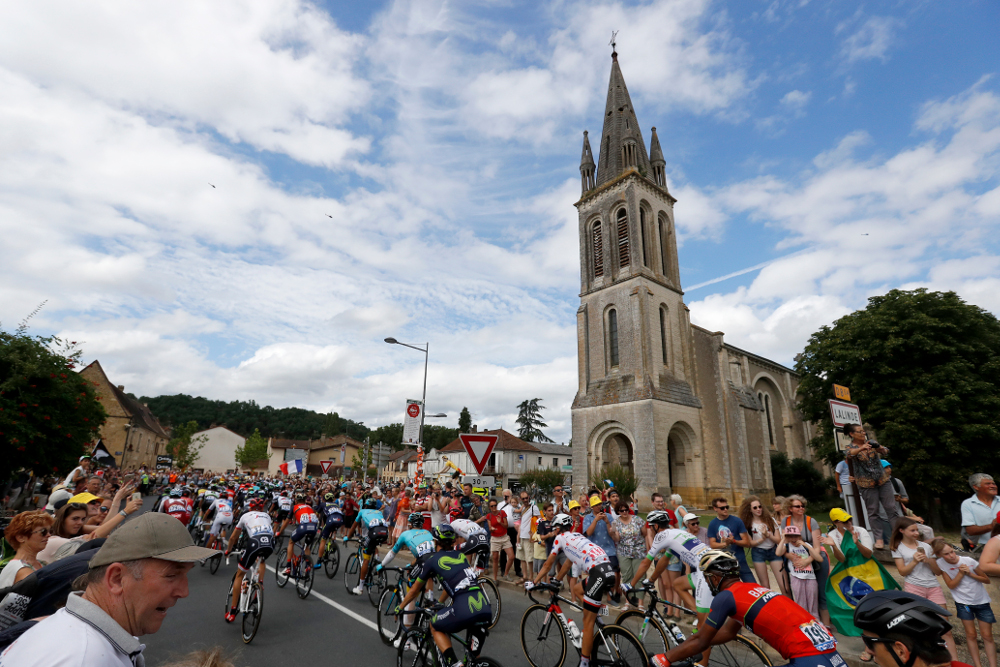
Riders pass St. Pierre Catholic Church during the 10th stage of the 104th Tour de France cycling race July 11 in Lalinde. (CNS/EPA/Guillaume Horcajuelo)
Problems aside, church leaders seem determined to turn the changes to advantage.
Catholics still make up 16 percent of the 16 million inhabitants of the Netherlands, which was Europe's first country to legalize brothels, cannabis, euthanasia and same-sex marriage, although only 5 percent now attend Mass, compared to 90 percent in the 1950s. A Catholic research group has estimated that two churches are currently closing weekly because of a lack of congregations, while all but 20 of the country's 170 monasteries will have been decommissioned by the end of next year.
Despite this, lay Catholics petitioned Pope Francis in 2015 in a bid to stop the closures, and accused Cardinal Willem Eijk, the bishops' conference president, of "destroying communities" when he proposed "melting down" his Utrecht Diocese's 326 parishes into 48 larger territorial units, each with a single church as "eucharistic center."
The parishes could be saved, the group insisted, if lay Catholics were allowed to celebrate the Eucharist and run their own communities. Eijk was unmoved.
"When I spoke to the pope, I warned that old church structures wouldn't exist by the time I retired — and that by 2025 two-thirds of our churches would have been withdrawn from divine worship," he told Dutch Catholics in a pastoral letter. "The pope was shocked, but repeated that we should move forward and not surrender to nostalgia for a past which will never reappear."
Roland Enthoven, the Utrecht Diocese spokesman, insists Catholics can still be a "creative minority" in countries like this through public witness and national involvement.
"But we've had to issue a wake-up call, so people will realize there's a cost to being a church community — in money, time and voluntary work," Enthoven said. "It may simply be that secularization is occurring faster in some places than others, and that dioceses like ours are merely ahead of the curve in taking these painful decisions."
[Jonathan Luxmoore covers church news from Oxford and Warsaw. His two-volume study of communist-era martyrs, The God of the Gulag, is published by Gracewing in the U.K.]








